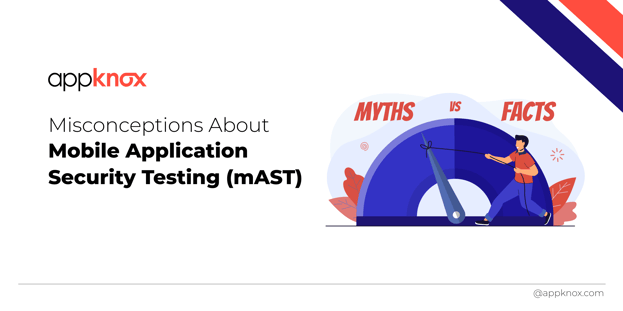
BLOG

BLOG
All app development companies are aware of the importance of mobile application security testing. Despite this, the app stores are full of potentially vulnerable apps.
One of the reasons for this is the myths surrounding the mobile application security testing concept - how it might be complicated or expensive to get security.
However, this blog will dispel these myths and present a true picture of mobile application security testing. By the end, you will be able to use security testing to its full potential.
Mobile apps have become dramatically popular over the past couple of years. No wonder there are over 1.96 million apps on the Apple App store and 2.65 million apps on the Google Play Store.
However, with the rising popularity of mobile apps, cyber-attacks are on the rise too. As a matter of fact, hackers think of mobile apps as an easy target which puts the data of several million users at risk. So, what should be done? That's when Mobile application security testing comes into the picture.
As a mobile app development company or a mobile app developer, you can opt for Mobile application security testing and develop mobile apps that are immune to attacks and fraud. We know you might have some myths blocking your mind. So, let's bust those myths and understand the importance of Mobile application security testing.
One of the most common misconceptions is that SAST is sufficient for ensuring mobile app security.
Yes, SAST or static application security testing helps find vulnerabilities in your mobile app's source code. However, it's a static method that fails to determine dynamic real-world issues, frameworks, and libraries, leaving the mobile app susceptible to cyber fraud.
Furthermore, SAST never flags issues pertaining to data at rest or data in transition, such as session hijacking, data caching, data stored in local storage, decrypted keychains, etc. And this makes SAST on its own an ineffective method of ensuring app security.
SAST helps test only the static aspect of your mobile application, which isn't enough to ensure complete security. Therefore, along with static testing, also opt for dynamic security testing for mobile applications. This will help you thoroughly test your mobile app and make it more secure.
Another common misconception is that web app testing tools & techniques can be used in place of mobile application security testing tools.
While mobile apps and web apps sound the same, they aren't. It's simply like comparing apples to oranges.
In web apps, the browser handles the communication with the application code chilling at the server behind a firewall, making the entire system simple to test.
On the flip side, there's a whole operating system underneath a mobile application that can interact with other apps, which could be malicious in nature. Furthermore, data in rest and motion needs to be monitored for a mobile app, which makes testing a mobile application complex.
Mobile apps are inherently different from web apps and are more complex in testing. Therefore, always use separate dedicated tools for mobile and web application security testing.
Google Play Store takes care of android app security testing, and Apple App Store takes care of iOS app security testing. If that's what you think, you're mistaken.
Google and Apple only release safe tools and frameworks for developers to build secure mobile applications. Once you upload your application, they scan it for guidelines and API compliance, vulnerabilities, and that's it.
Google and Apple don't check for dynamic issues, app functionality, third-party libraries loophole, etc. It's your job to do that. Therefore, never skip Mobile application security testing, thinking that Google or Apple will take care of that. You could be simply risking your users' safety.
Yes, in some instances, hackers do target popular applications or apps developed by popular companies considering higher user adoption, revenue, etc. However, that's true only if the hackers perform a targeted attack.
Unfortunately, hackers perform another prevalent type of attack: a non-targeted attack, wherein the attacker chooses a specific language or vulnerability in a 3rd party library to attack whatever company uses it regardless of its size, turnover, or user base.
Both small and large companies are on the hit list of hackers or cyber criminals. Therefore, regardless of your company's size, you must opt for mobile application security testing.
Yes, hackers or cybercriminals are after money, bank details, credit card information, etc.
However, that's not the only thing they're after. There's one more thing in real demand, especially on the dark net: personal data such as name, email, IP address, etc. And sadly, the above data is captured by every app regardless of its domain.
If your application deals with the user's personal information, such as name, email, address, or IP, which almost every app does, it's an active target for hackers. Therefore, you must opt for stringent mobile application security testing protocols and ensure safety.
In a nutshell, both small and large companies are on the hit list of hackers or cyber criminals. Therefore, regardless of company size and financial status, you must opt for mobile application security testing.
Mobile application security testing is crucial to make the applications you develop more stringent and resilient to cyber-attacks. So, try to make it a common practice at your company and deliver more secure apps than ever.
Now that popular misconceptions about mobile app security testing have been debunked, you can explore essential cybersecurity resources in our myths vs facts series:
Misconceptions about SAST For Mobile
Misconceptions about DAST For Mobile
Misconceptions about API Security Testing (APIT)
Misconceptions About Penetration Testing
These resources will help level up your mobile app security knowledge and enhance your organization's cybersecurity curve and readiness.

Hackers never rest. Neither should your security!
Stay ahead of emerging threats, vulnerabilities, and best practices in mobile app security—delivered straight to your inbox.
![]() Exclusive insights. Zero fluff. Absolute security.
Exclusive insights. Zero fluff. Absolute security.
![]() Join the Appknox Security Insider Newsletter!
Join the Appknox Security Insider Newsletter!
